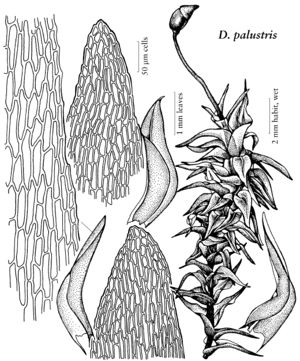Dicranella palustris
Trans. Brit. Bryol. Soc. 4(2): 247. 1962,.
Plants relatively robust, 2–11 cm, in loose, light-green or yellow, ± shiny tufts. Leaves not crowded, 2.5–3 mm, abruptly narrowed to a narrow, squarrose limb from an erect, oblong or obovate base, subtubulose and generally ± twisted-crispate when dry, concave when moist, often cucullate at a rounded though often narrow apex, decurrent at base; margins erect, irregularly crenate at the extreme tip; costa subpercurrent, smooth abaxially; distal cells elongate, 4–9: 1, the basal-cells longer, yellow at the insertion, often ± differentiated at extreme basal angles. Sexual condition dioicous. Seta 10–30 mm, dark red. Capsule 1–1.5 mm, curved-inclined, smooth; annulus present or absent; operculum stoutly conic-rostrate; peristome teeth ca. 500–650 µm, divided about 1/2 way distally, vertically papillose-striolate. Spores 16–25 µm, smooth or papillose.
Phenology: Capsules mature spring.
Habitat: Wet soil in springy places, often at roadsides, sometimes temporarily submerged, probably an acidophile
Elevation: low to medium elevations
Distribution
Greenland, Alta., B.C., N.B., Nfld. and Labr. (Nfld.), N.S., Que., Yukon, Alaska, Calif., Maine, Mont., N.H., Ohio, Oreg., Wash., Europe, Asia (Japan), Asia (Turkey)
Discussion
Dicranella palustris is known by its squarrose-spreading, decurrent leaves ending in a narrow but rounded and crenulate tip. Lax, relatively large expressions of D. schreberiana, often given recognition as var. robusta, are smaller and have leaves with slender, acute tips, serrated margins, and broad cells. The New Hampshire and California reports were by A. J. Grout (1928–1940, vol. 1, as D. squarrosa) and D. H. Norris and J. R. Shevock (2004), respectively.
Selected References
None.
